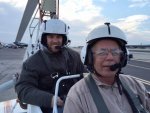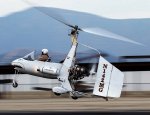Hello everyone (thanks for the Registration help Todd).
I'm a retired firefighter looking to get a Sport Pilot license (because low and slow around the patch is what I'm most interested in). Initially I wanted to home build a fixed wing LSA but I've recently experienced a renewed interest in gyroplanes but I have a few questions, thanks.
1) Safety. I like that there is less consequence to engine failure since there is a rotor above you that can provide a better chance (than fixed wing) of a safe landing, True? However, loss of that rotor or its function, however remote, I would imagine lead to a gyroplane abruptly dropping out of the sky (no fixed wing glide). Question- Are ballistic parachutes 'normally' installed on gyroplanes? Can they be? Do any of you where a parachute? Could anyone reasonably expect to be able to bail out of gyroplane?
2) Cost. It looks as though gyroplanes are 'easily' trailable so if need be one could be stored in a garage in order to avoid hanger or tie down fees. Anyone actually doing so? Being N numbered, having more moving parts and a certified engine, are gyrocopters more expensive to maintain than a typical fixed wing LSA?
3) Where best to fly. I live in So. Cal., north of San Diego. I see there is a PRA Chapter out in El Cajon, over 40 miles away from me, also there is an annual(?) gyro fly-in out in the desert up by LA. Are there other locations that gyroplane pilots are hanging out and flying?
Thanks again.
Mike
I'm a retired firefighter looking to get a Sport Pilot license (because low and slow around the patch is what I'm most interested in). Initially I wanted to home build a fixed wing LSA but I've recently experienced a renewed interest in gyroplanes but I have a few questions, thanks.
1) Safety. I like that there is less consequence to engine failure since there is a rotor above you that can provide a better chance (than fixed wing) of a safe landing, True? However, loss of that rotor or its function, however remote, I would imagine lead to a gyroplane abruptly dropping out of the sky (no fixed wing glide). Question- Are ballistic parachutes 'normally' installed on gyroplanes? Can they be? Do any of you where a parachute? Could anyone reasonably expect to be able to bail out of gyroplane?
2) Cost. It looks as though gyroplanes are 'easily' trailable so if need be one could be stored in a garage in order to avoid hanger or tie down fees. Anyone actually doing so? Being N numbered, having more moving parts and a certified engine, are gyrocopters more expensive to maintain than a typical fixed wing LSA?
3) Where best to fly. I live in So. Cal., north of San Diego. I see there is a PRA Chapter out in El Cajon, over 40 miles away from me, also there is an annual(?) gyro fly-in out in the desert up by LA. Are there other locations that gyroplane pilots are hanging out and flying?
Thanks again.
Mike



